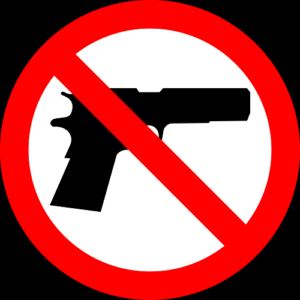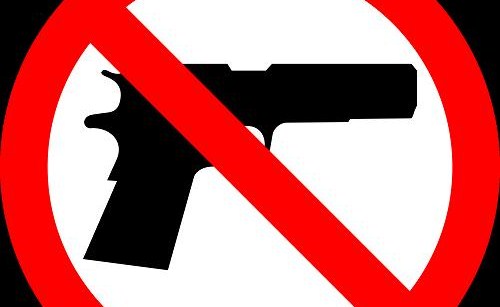22 February 2018
A Deadly Business
The Marjory Stoneman Douglas High School shooting.
By Neil Tidmarsh
 Here’s a question: which is more difficult to buy in the USA – a handgun or an assault rifle?
Here’s a question: which is more difficult to buy in the USA – a handgun or an assault rifle?
Well, a rifle, surely? Isn’t it obvious – the deadlier the weapon, the more difficult it is to get your hands on it?
Wrong. You have to be at least 21 years old to buy a handgun – but only 18 years old to buy a rifle. When you buy a handgun in Florida, you have to wait for three days for checks before you can take possession; when you buy a semi-automatic rifle, you can take it out of the shop after a one-minute background check.
Most Brits feel at home in the USA, but gun ownership is perhaps the one aspect of its culture which we’ll never understand. The simple, straightforward, up-front New Worlders are supposed to find us Old Worlders a perplexing and complicated jumble of paradoxes, contradictions and ironies; but when it comes to their gun culture it’s the other way round.
Another question. As far as gun-makers and gun-sellers are concerned, which of the following are good for business and which are bad for business: Republican governments; Democrat governments; mass killings such as school shootings?
It’s obvious, isn’t it? Republican governments good for business; Democrat governments bad for business; mass shootings bad for business…
Wrong again.
Anyone who has played cowboys and Indians or watched a Western will know that Remington Arms is one of the biggest and most famous of the USA’s manufacturers of firearms and ammunition. It has a history going back more than two centuries and has almost 4000 employees. And last week it filed for bancruptcy. Business nose-dived when Trump became president. What? Trump, the libertarian, the Republican, the NRA’s darling, the president least likely to introduce firearms controls? Bad for the gun business? If you think that’s a paradox, here’s another one; gun sales boomed during the Obama era, spiked after every mass shooting, and peaked when it looked as if Hilary Clinton was going to make it to the White House.
The explanation is simple and rational enough; panic buying. Customers rush out and buy guns when it looks as if their chance to do so is about to be taken away, e.g. when they have a president who calls for gun-control, or in the aftermath of atrocities when the argument for tough new gun-laws seems incontestable. On the other hand, of course, customers feel no urgency about building up their arsenals when they have a president who has sworn to preserve their right to bear arms; sales fall off, retailers are buried under mountains of unsold stock, and manufacturers go bust. Remington made a loss of $28 million last year.
That’s enough of paradox and contradiction (for the moment). Time for irony, as dark and tragic as it comes.
Only a day or two after Remington Arms went bust, a 19 year old boy walked into the Marjory Stoneman Douglas High School in Parkland, Florida, and opened fire on teachers and students with a semi-automatic assault rifle, killing 17 of them (3 staff and 14 pupils) and injuring another 14. It was Valentine’s Day.
The boy had been expelled from the school a year ago, was known to have mental health problems, had a history of brushes with the law, and had broadcast his murderous ambitions on social media. Nevertheless he had managed to obtain a whole arsenal of firearms. The weapon he used last week was an AR-15 style rifle, a battlefield weapon designed for soldiers, and yet here it was, being used by a civilian to kill other civilians in a school, far from any battlefield.
The Times reported it as “the 30th mass shooting in America this year”, something I can’t believe even though it’s The Times telling me so. The 30th! And it’s only February! 18 of those have been school shootings – that means 3 every week! There have been at least 239 school shootings since 2014 – about one a week! And before that, in 2012, one of the worst incidents occurred at the Sandy Hook school when 20 children and 3 staff were killed. Last October, 58 people were killed in Las Vegas by a gunman shooting from a hotel window. Each and every one of those incidents has triggered calls for stricter gun control, but each and every one of those calls has come to nothing.
Will it be any different this time? Already there are signs that indeed it might. There are a number of significant differences between the Marjory Stoneman Douglas High School atrocity and its predecessors. First of all, mobile phone footage taken by survivors and broadcast on social media has sent vivid and powerful witnesses all around the country, has almost turned the whole country into a witness. Second, the (alleged) perpetrator’s profile and intentions were so blatant that questions about how he obtained firearms and escaped the notice of security will not be easily silenced. Third, the (alleged) perpetrator was arrested – unusually he didn’t kill himself nor was he killed by the police in a shoot-out – so he will stand trial; and that trial and his evidence is sure to maintain the momentum of the gun-control campaign. Fourth and most significant, the students at MSD, being high-school students, are older than the children at Sandy Hook, for instance; at the age of 17 or 18, they are old enough to make their voices heard, to organise themselves effectively and to sustain a long-running campaign; at the same time they are young enough to have the passion and energy to insist on success. They’re calling for a march on the Capital in Washington for March 24 (surely a nobler idea than the President’s plan for a military parade in Washington to glorify weapons), and students have begun to protest in front of the White House chanting “Hey, hey, NRA, how many kids did you kill today?”
Already President Trump is indicating that he is willing to take action. He was criticised for his initial reactions – blaming the alleged perpetrator’s mental health rather than the system which allowed him to obtain deadly weapons, and insensitively and crassly giving the cameras a big grin and a thumbs-up inappropriate to the sombre occasion, when visiting Parkland – but now mounting pressure has forced him to order the attorney general “to propose regulations that ban all devices that turn legal weapons into machine-guns”. It looks like the ‘bump-stock’ (a device which can transform a semi-automatic rifle into an automatic rifle – a rifle which will fire a hail of bullets with one touch of the trigger) will be banned at last. It’s a start.
It’s shocking to think that those 17 deaths might have brought the death-dealing Remington Arms back to life had they occurred a week or two earlier; it’s still sickening to think that this tragedy might bring crowds of gun-lovers back to the gun-shops on another panic-buying spree, to the obscene delight of retailers seeing their previously becalmed armadas of stock on the move again. Nevertheless, that irony or paradox or contradiction is more than off-set by the more pleasing one that Trump and the Republicans, of all parties and all presidents, might find themselves having to pass long-awaited gun-control laws at last.


